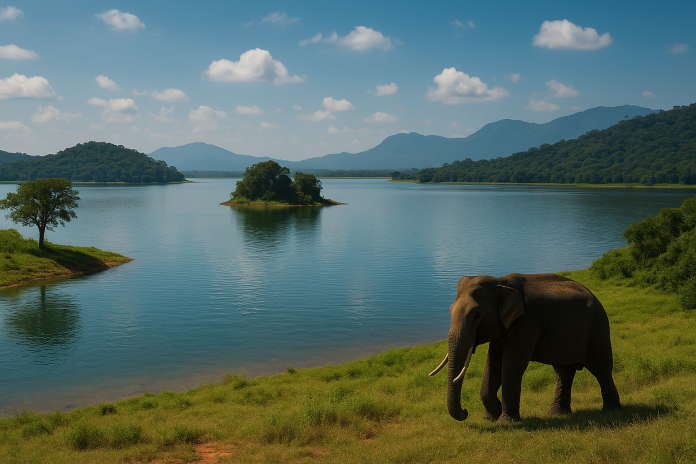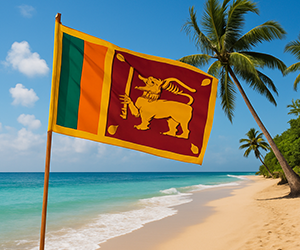Introduction to Gal Oya National Park
Gal Oya National Park, nestled in the serene eastern reaches of Sri Lanka, is a sanctuary of biodiversity and tranquility. This lesser-known gem stands apart as the only national park in Sri Lanka that offers the rare experience of boat safaris. Far from the tourist-packed zones of Yala and Udawalawe, Gal Oya provides a pristine escape into the heart of nature, where elephants swim between islands and birds soar across untouched skies. For wildlife enthusiasts, birdwatchers, eco-travelers, and cultural explorers, Gal Oya National Park is a must-visit destination.
History and Significance
Established in 1954, Gal Oya is one of Sri Lanka’s oldest national parks. It was created to protect the watershed of the Senanayake Samudraya, the country’s largest reservoir. This artificial lake and its surrounding ecosystems have since become a refuge for diverse flora and fauna. The park covers more than 25,000 hectares, combining dry evergreen forests, savannah grasslands, and aquatic habitats. Its ecological significance is immense, providing a safe haven for many endangered and endemic species.
Location and How to Get There
Gal Oya is located in the Ampara District of Sri Lanka’s Eastern Province. While remote, the journey to this untouched wilderness is part of the adventure.
- From Colombo: Approximately 6-7 hours by car via Mahiyanganaya.
- From Kandy: Around 4-5 hours through the scenic central highlands.
- From Ella or Arugam Bay: 3 to 4 hours by road.
Public buses reach Ampara or Inginiyagala, and from there, you can hire a tuk-tuk or taxi to the park.
Unique Features of Gal Oya National Park
Gal Oya stands out as the only park in Sri Lanka where you can go on boat safaris, a rare experience in Asia. As you cruise across Senanayake Samudraya, you may witness one of nature’s most remarkable sights: elephants swimming from one island to another. The panoramic beauty of the park—lush forests hugging the blue waters, distant hills framing the horizon—adds a cinematic quality to your visit. With minimal tourist interference, the encounters with wildlife feel intimate and authentic.
Wildlife of Gal Oya
Gal Oya hosts a broad spectrum of wildlife:
- Mammals: Asian elephants, sloth bears, leopards (rare), spotted deer, sambur, wild boar, and water buffalo.
- Reptiles: Mugger crocodiles, monitor lizards, and pythons.
- Amphibians: Various species thrive in the wet zones and waterbodies.
- Insects and butterflies: Especially rich during the rainy season.
The park is a paradise for nature lovers who want to experience fauna in undisturbed environments.
Birdwatching in Gal Oya
With over 150 recorded bird species, Gal Oya is a paradise for birdwatchers:
- Water birds: Indian cormorant, grey heron, and lesser whistling duck.
- Raptors: Crested serpent eagle and white-bellied sea eagle.
- Endemics: Sri Lanka green pigeon and Sri Lanka grey hornbill.
The best times for birdwatching are early mornings and late afternoons. Bring a pair of binoculars and a field guide for an immersive experience.
Boat Safaris at Senanayake Samudraya
The boat safaris at Gal Oya are a once-in-a-lifetime experience.
- Tour Duration: Typically lasts 2 to 3 hours.
- Best Time: Morning (6-9 AM) and evening (3-6 PM).
- Highlights: Swimming elephants, crocodiles basking on rocks, birds in flight, and the serene island-studded waters.
These safaris offer incredible photography opportunities. Boats are operated by experienced guides who ensure safety and enhance the wildlife viewing experience.
Jeep Safaris and Nature Walks
While less promoted than boat safaris, jeep safaris through the park reveal hidden corners of forest and grassland.
- Jeep tours: Cover zones with higher chances of spotting elephants, deer, and rare birds.
- Nature walks: Offered with naturalists and Vedda guides; these highlight medicinal plants, animal tracks, and traditional knowledge.
- Stargazing: With minimal light pollution, night skies are clear and ideal for astronomy.
Vedda Community Experience
Gal Oya is also culturally significant as home to the Vedda people, Sri Lanka’s indigenous forest-dwelling tribe.
- Visitors can take guided walks with Vedda leaders who explain their sustainable way of life.
- These tours offer insights into herbal medicine, hunting tools, ancient customs, and animistic beliefs.
- Engaging with the Vedda is a respectful way to understand the human-nature relationship that has existed for centuries.
Best Time to Visit Gal Oya
- March to July: Ideal for elephant sightings, especially swimming in the reservoir.
- October to January: Lush vegetation and full reservoir levels make for beautiful scenery and birdwatching.
- Avoid: November and December when monsoons can affect road conditions and safari availability.
Where to Stay Near Gal Oya
Options range from rustic to luxury, with eco-consciousness a common thread:
- Gal Oya Lodge: An upscale eco-lodge with naturalist-led activities.
- Wild Glamping Gal Oya: Tented luxury with views of the wilderness.
- Local Guesthouses and Homestays: Budget-friendly and community-supported.
Most accommodations offer safari packages and authentic Sri Lankan meals.
Travel Tips for Visitors
- Park Hours: Usually open from 6 AM to 6 PM.
- Entrance Fee: Payable at the Wildlife Department checkpoint.
- Packing List:
- Light cotton clothes
- Insect repellent
- Sunscreen and hat
- Binoculars and camera
- Refillable water bottle
- Respect wildlife: No feeding, no loud noises, and leave no trace.
Nearby Attractions
- Buddhangala Monastery: A historic hilltop temple with panoramic views.
- Nilgala Forest Reserve: Known for orchids and butterflies.
- Lahugala Kitulana National Park: A seasonal elephant gathering site.
- Arugam Bay: Just 2-3 hours away, ideal for beach lovers and surfers.
Conservation and Sustainability Efforts
Managed by the Department of Wildlife Conservation, Gal Oya remains relatively untouched due to its isolation and low tourist footfall.
- Challenges: Human-wildlife conflict, encroachment, climate shifts.
- Solutions: Community awareness, eco-tourism, Vedda integration, and scientific research.
Your visit directly supports these efforts by creating economic value for conservation and promoting responsible travel.
Why Gal Oya Should Be on Your Itinerary
Unlike the bustling and often overcrowded safari destinations, Gal Oya offers an experience rooted in peace, intimacy, and ecological harmony. Whether you’re floating across its vast reservoir watching elephants in the wild, walking beside a Vedda elder learning ancient stories, or listening to birdsong from your eco-lodge veranda, Gal Oya leaves a lasting imprint.
Conclusion
Gal Oya National Park is a remarkable blend of biodiversity, cultural heritage, and untouched beauty. It represents what responsible tourism in Sri Lanka can look like: immersive, educational, sustainable, and deeply enriching. For travelers who value nature and authenticity over crowds and commercialization, Gal Oya is a must-visit destination that offers more than just sights—it offers connection.




